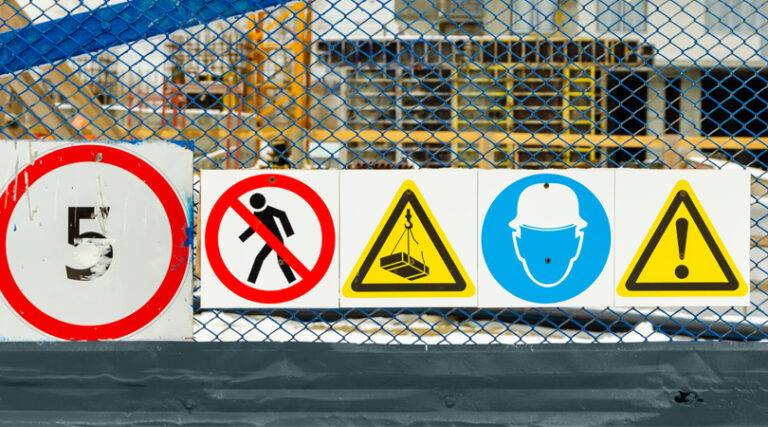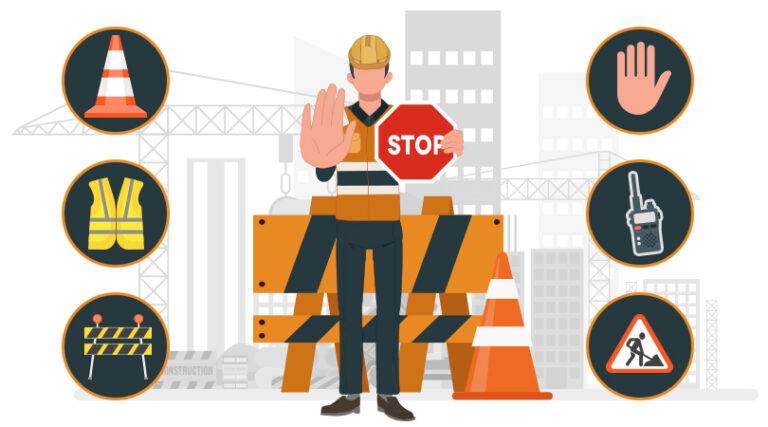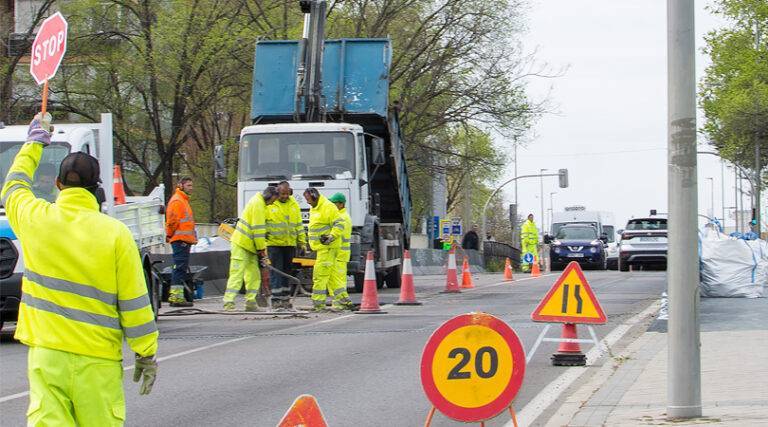Are your construction sites often the scene of serious accidents? Then this blog is for you.
If you run a construction company, you are more than aware of how hectic a job site can be. With so many construction workers, building materials, tools, and heavy equipment around, it becomes utterly chaotic almost at all times. But what is the biggest barrier to running a construction project smoothly? Yes, you guessed it right. It is the wave of traffic that you have to manage in and around your project site. Now, if you expect your technicians to manage the traffic as well as the construction work, things will become more difficult for them. And this right here is the key cause of recurrent accidents at your job sites– your technicians are constantly juggling two high-risk jobs, and therefore, things are slipping through the cracks. However, there is a simple solution to this problem—a construction flagger, or a team of construction flaggers, to be more specific.
Hiring human flaggers for construction sites has become quite popular lately. The increased demand for skilled and experienced flaggers is proof of this claim. Today, there are about 29,023 active vacancies for flaggers in the U.S. alone, and the demand is steadily increasing. There is a strong reason behind this.
Hiring flaggers for your construction site gives your workers freedom from the heavy task of managing traffic and instead allows them to focus on the job that they are actually meant to do. If you have already used them for your business, you know more than anyone how relieving it could be for you and your workers. And if you haven’t tried it yet, you should consider it right now. You will be amazed at the difference it makes to your workflow and productivity.
Increase productivity with Field Promax Flagger Management Software. Sign Up Now!.
At this point, you might want to know more about construction flaggers—what is a construction flagger, how they can help you, how to hire them, and most importantly, how much it is going to cost you. Well, we have tried to answer almost all of your questions right in this blog. So, read on and learn the secret to taking your construction business to the next level.

Construction Flaggers: An Overview
Essentially, flaggers are professionals who help with the task of traffic control. You might have already seen some of them—managing traffic and keeping both drivers and workers safe during temporary roadwork. But what is a flagger in construction?
Well, they are the same people hired specifically to work on construction sites. Government agencies and construction firms hire construction flaggers to keep traffic moving around construction sites. With construction flaggers, handling a high-risk and chaotic space like that of a construction zone becomes rather easy.
The primary role of a construction flagger is to control the movement of vehicular and pedestrian traffic in and around construction sites. They serve as the eyes and ears on the ground, orchestrating the flow of traffic to ensure the safety of both workers and passersby. Flaggers typically work in teams, strategically positioning themselves at key points along roadways to guide vehicles safely through construction zones.
The job responsibilities of flaggers include:
-
- Traffic Management
Flaggers are responsible for directing traffic using hand signals, flags, or signs. They must have a comprehensive understanding of traffic regulations and construction site plans to effectively manage the movement of vehicles.
-
- Safety Enforcement
Ensuring the safety of workers, motorists, and pedestrians is paramount. Flaggers must enforce safety protocols, such as speed limits and the proper use of personal protective equipment (PPE), to mitigate the risk of accidents.
-
- Communication
Effective communication is essential for flaggers. They must relay instructions clearly to motorists and workers alike, using hand signals, verbal commands, or two-way radios. Clear communication helps prevent confusion and ensures smooth traffic flow.
-
- Alertness
Construction sites are dynamic environments where hazards can emerge unexpectedly. Flaggers must remain vigilant at all times, scanning for potential dangers and reacting swiftly to prevent accidents.
-
- Coordination
laggers often collaborate closely with construction crews, equipment operators, and law enforcement personnel to coordinate activities and ensure the safe movement of traffic. Strong teamwork and coordination are essential for maintaining order in busy work zones.
-
- Adaptability
Construction projects can vary widely in scope and complexity, requiring flaggers to adapt to changing conditions quickly. Whether managing traffic during road repairs, bridge construction, or utility maintenance, flaggers must remain flexible and adaptable to ensure safety.
-
- Emergency Response
In the event of an accident or emergency, flaggers may be required to assist emergency responders by providing traffic control and directing vehicles away from danger zones. Their quick thinking and ability to maintain composure under pressure are invaluable in such situations.
How to Manage Construction Zones with Construction Flaggers
Managing a construction site with flaggers primarily refers to maintaining safety and seamless working conditions. In short, construction flaggers ensure the complete safety of a job site so that construction workers and other technicians can do their jobs right. Flaggers also make sure that no worker or motorist is harmed or injured due to road accidents, property damage, falling hazards, chemical hazards, or any other risks that may arise at a construction site. To this end, they carry out the following tasks under the supervision of an experienced team leader:
- Putting up warning signs like traffic cones and roadblocks
- Use hand signals and other signs to direct the flow of traffic
- Make the construction crew aware of various security regulations
- Maintain safety at the job site
- Use hand-held radios for communicating with other flaggers and guiding traffic from two lanes into just one
- Dealing with difficult motorists
- Note down vehicle numbers in case anyone fails to obey traffic rules and regulations
- Take down all the signs, barricades, and traffic cones when the construction is done
- Help the construction workers clear away rubble, debris, and dangerous materials
- Help the site get back to normal for traffic movement.

While the construction flaggers will make sure of their responsibilities, you need to take care of a few things if you want to manage the construction zone with flaggers more effectively. This includes:
-
- Develop a Traffic Control Plan
Before beginning any construction work, develop a comprehensive traffic control plan in accordance with local regulations and guidelines. Identify key points where flaggers will be stationed to manage traffic flow safely through the construction zone.
-
- Provide Proper Training
Ensure that all flaggers receive adequate training in traffic control procedures, safety protocols, and communication techniques. Training should cover topics such as signaling techniques, understanding traffic patterns, and emergency response procedures.
-
- Assign Duties and Responsibilities
Clearly define the duties and responsibilities of each flagger based on their assigned location within the construction zone. Assign specific roles, such as directing traffic, controlling access to the work area, or assisting pedestrians in crossing safely.
-
- Coordinate with Construction Crews
Collaborate closely with construction crews to coordinate activities and minimize disruptions to traffic flow. Communicate regularly with project managers, equipment operators, and other personnel to ensure that construction activities align with traffic control measures.
-
- Implement Visible Signage
Use highly visible signage, barricades, and cones to delineate the boundaries of the construction zone and alert motorists to upcoming changes in traffic patterns. Ensure that signage is placed strategically to provide clear guidance to drivers approaching the work area.
-
- Monitor Traffic Flow
Continuously monitor traffic flow within the construction zone to identify potential congestion or safety hazards. Adjust flagger positions or traffic control measures as needed to maintain smooth traffic flow and prevent accidents.
-
- Maintain Communication
Establish effective communication channels between flaggers, construction crews, and project supervisors to relay important information in real-time. Use two-way radios or hand signals to communicate quickly and efficiently, especially in noisy or chaotic environments.
-
- Enforce Safety Protocols
Enforce strict adherence to safety protocols among flaggers and construction personnel to minimize the risk of accidents or injuries. Emphasize the importance of wearing high-visibility clothing, using proper signaling techniques, and following established traffic control procedures at all times.
-
- Plan for Emergencies
Develop contingency plans for responding to emergencies such as accidents, inclement weather, or equipment malfunctions. Ensure that flaggers are trained to handle emergency situations effectively and know how to communicate with emergency responders if needed.
-
- Evaluate and Adjust
Regularly evaluate the effectiveness of traffic control measures and flagger operations and make adjustments as necessary based on feedback from flaggers, construction crews, and stakeholders. Continuously strive to improve safety and efficiency within the construction zone.
Cost of Hiring Construction Flaggers
Many construction business owners refrain from hiring flaggers, thinking of the additional cost it would incur. If you are one of them, let us assure you that hiring a construction flagger is way less expensive than you think. In the U.S., you need to pay a flagger just $16.11 per hour.
If this amount still feels like a lot, think about the costs it saves. Having a team of experienced flaggers reduces the chances of accidents to almost zero. As a result, you save money on hazards, damages, and insurance claims for worker injuries. Not to forget the lives it will save!
Moreover, having a team of flaggers on a construction site is a mandatory requirement in some specific locations. If you violate that rule, you may end up paying a heavy penalty. The cost of hiring flaggers will be way less than that.
All in all, hiring flaggers saves you more money than it costs you and, therefore, is indeed a wise investment.
Make the best investment decision for your construction business. Sign up for Field Promax.
How to Find and Recruit Flaggers for Construction Projects
-
- Define Specific Requirements
Start by clearly defining the qualifications, experience, and skills needed for the role of a flagger on your construction projects. Consider factors such as relevant certifications, experience in traffic management, communication skills, and the ability to work effectively in a fast-paced environment.
-
- Utilize Recruitment Platforms
Make use of online job boards, industry-specific websites, and recruitment agencies to advertise job openings for flaggers. These platforms can help you reach a wider pool of candidates with the necessary skills and experience.
-
- Network Within the Industry
Leverage your connections within the construction industry to seek referrals for potential flagger candidates. Attend industry events, workshops, and seminars where you can meet professionals who may know qualified individuals seeking employment.
-
- Promote Training and Development
Consider providing training opportunities for individuals interested in becoming flaggers. Partnering with local training programs or offering in-house training can help attract candidates who are eager to learn and develop their skills in traffic management.
-
- Conduct Thorough Interviews
When screening candidates, conduct thorough interviews to assess their qualifications, experience, and suitability for the role. Ask targeted questions to gauge their understanding of traffic control procedures, their ability to handle stressful situations, and their commitment to safety.
-
- Evaluate Communication Skills
Effective communication is crucial for flaggers, as they must interact with both workers and the public on a daily basis. Assess candidates’ communication skills during the interview process, paying attention to their clarity, confidence, and ability to relay instructions effectively.
-
- Prioritize Safety and Reliability
Look for candidates who prioritize safety above all else and demonstrate a strong sense of responsibility and reliability. Seek individuals who understand the importance of adhering to safety protocols and who can be counted on to consistently perform their duties with professionalism and diligence.
How to Manage Construction Flaggers Effectively
Once you put together your team of certified construction flaggers, you need to learn how to manage them on a construction site.
Of course, your flaggers will control the traffic movement and ensure safety. But there are a lot more important things to take care of, even before they set foot in the construction zone. And it is upon you to handle them.
First of all, you need to assign flaggers and give them a schedule. Then you need to monitor when they arrive at the site, clock-in, and clock out. You might also need to track their movements in certain high-risk construction zones. Don’t forget tracking total billable hours for payroll too! Additionally, sometimes flaggers may need to use some equipment other than flagger signs and barricades. In that case, it is important to keep track of that equipment and make sure that it is available for them to use as and when necessary.

It sounds like a lot of work, right? This time, we’re going to agree with you. Yes, it is indeed a hectic task that takes a lot of time and effort—only when done manually. But it all becomes a cakewalk if you simply automate the process.
That’s right. There are now advanced digital tools and software applications that can streamline the workflow. You can schedule, dispatch, and monitor your flaggers, track their time, and even send automated alerts and notifications so they never miss a shift.
If you are thinking of using a time-tracker or scheduling software to manage your construction flagger, let us give you one more tip, perhaps the best one so far. Sign up for a flagger management software system instead.
Flagger management software is essentially an advanced field service management software tailored for construction management. Packed with a wide range of smart features, this cutting-edge digital tool streamlines operations and enhances productivity on construction sites.
By automating key processes such as scheduling, communication, and reporting, this software provides a centralized platform for managing flagger activities efficiently. Through the software, supervisors can easily assign flagger duties, track their locations in real-time, and communicate important instructions or updates instantly. Additionally, features such as automated scheduling and route optimization help ensure optimal deployment of flaggers, minimize downtimes, and maximize productivity. Moreover, the software can generate detailed reports and analytics on flagger performance and traffic flow, allowing for data-driven decision-making and continuous improvement. By simplifying task management, improving communication, and providing valuable insights, field service management software for construction flagger management empowers construction companies to enhance safety, efficiency, and overall project success.
To sum up the whole discussion, the best way to manage a construction site using construction flaggers is by leveraging a flagger management software system. This helps automate tedious backend tasks, such as scheduling, dispatching, monitoring, reporting, time-tracking, and more, in an efficient manner, thus eliminating the risks of manual errors and mismanagement. Moreover, it saves valuable time and effort on the part of managers and dispatchers, allowing them to be more watchful of safety measures and maintain productivity.
This brings us to another crucial question—which flagger management software is best for construction projects? In today’s market, you’ll find plenty of software solutions claiming to offer lucrative deals and fascinating features. However, most of them are essentially generic field service management software or project management software systems.
Cue Field Promax—the custom made flagger management software specifically designed to automate the task of handling flaggers. It is a comprehensive cloud-based solution optimized for mobile devices. With Field Promax, you can oversee all the necessary tasks of flagger management on one single platform.
Field Promax also offers a comprehensive dashboard where you can view all schedules, both for your flaggers and construction workers, and assign them accordingly. And the best part—it also has a mobile app, which helps your flaggers update time, report progress, access necessary information, and even upload photos and documents necessary for record-keeping. In short, Field Promax takes care of the entire process of managing flaggers effectively, with added efficiency and transparency.
Don’t waste any more of your valuable time. Just sign up for Field Promax and start managing your team of flaggers more efficiently than ever!
For more information, Contact FIELD PROMAX.
